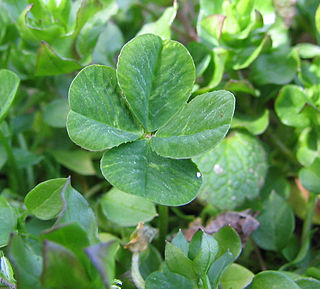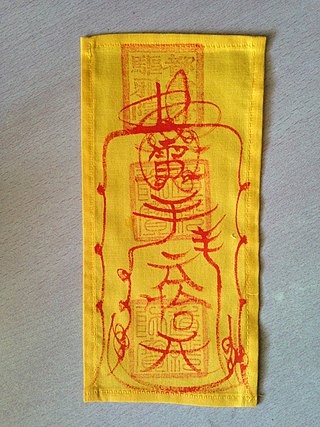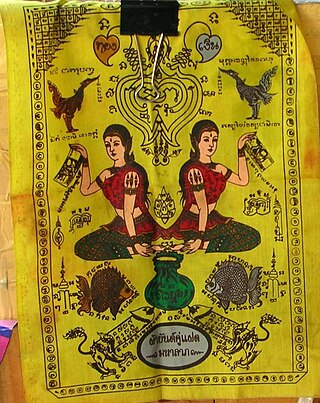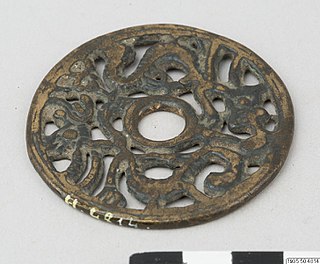
Luck is the phenomenon and belief that defines the experience of improbable events, especially improbably positive or negative ones. The naturalistic interpretation is that positive and negative events may happen at any time, both due to random and non-random natural and artificial processes, and that even improbable events can happen by random chance. In this view, the epithet "lucky" or "unlucky" is a descriptive label that refers to an event's positivity, negativity, or improbability.

A Daruma doll is a hollow, round, Japanese traditional doll modeled after Bodhidharma, the founder of the Zen tradition of Buddhism. These dolls, though typically red and depicting the Indian monk, Bodhidharma, vary greatly in color and design depending on region and artist. Though considered a toy by some, Daruma has a design that is rich in symbolism and is regarded more as a talisman of good luck to the Japanese. Daruma dolls are seen as a symbol of perseverance and good luck, making them a popular gift of encouragement. The doll has also been commercialized by many Buddhist temples to use alongside the setting of goals.

In some cultures, a rabbit's foot is carried as an amulet believed to bring good luck. This belief is held by people in a great number of places around the world, including Europe, China, Africa, Australia and North and South America. In variations of this superstition, the rabbit it came from must possess certain attributes, such as having been killed in a particular place, using a particular method, or by a person possessing particular attributes.

Omamori are Japanese amulets commonly sold at Shinto shrines and Buddhist temples, dedicated to particular Shinto kami as well as Buddhist figures, and are said to provide various forms of luck and protection.

Apotropaic magic or protective magic is a type of magic intended to turn away harm or evil influences, as in deflecting misfortune or averting the evil eye. Apotropaic observances may also be practiced out of superstition or out of tradition, as in good luck charms, amulets, or gestures such as crossed fingers or knocking on wood. Many different objects and charms were used for protection throughout history.

The hamsa, also known as the hand ofFatima, is a palm-shaped amulet popular throughout North Africa and in the Middle East and commonly used in jewellery and wall hangings. Depicting the open hand, an image recognized and used as a sign of protection in many times throughout history, the hamsa has been traditionally believed to provide defense against the evil eye.

Gris-gris is a Voodoo amulet originating in West Africa which is believed to protect the wearer from evil or bring luck, and in some West African countries is used as a purported method of birth control. It consists of a small cloth bag, usually inscribed with verses from an ancestor and a ritual number of small objects, worn on the person.

Agimat, also known as anting or folklorized as anting-anting, is a Filipino word for "amulet" or "charm". Anting-anting is also a Filipino system of magic and sorcery with special use of the above-mentioned talismans, amulets, and charms. Other general terms for agimat include virtud (Virtue) and galing (Prowess).

Fulu are Taoist magic symbols and incantations, translatable into English as 'talismanic script', which are written or painted on talismans called 靈符; 灵符; língfú by Taoist practitioners.

An amulet, also known as a good luck charm or phylactery, is an object believed to confer protection upon its possessor. The word "amulet" comes from the Latin word amuletum, which Pliny's Natural History describes as "an object that protects a person from trouble". Anything can function as an amulet; items commonly so used include statues, coins, drawings, plant parts, animal parts, and written words.

A kitchen witch, sometimes called a cottage witch is a homemade poppet or doll resembling a stereotypical witch or crone displayed in residential kitchens as a good luck charm and to ward off bad spirits.

A superstition is any belief or practice considered by non-practitioners to be irrational or supernatural, attributed to fate or magic, perceived supernatural influence, or fear of that which is unknown. It is commonly applied to beliefs and practices surrounding luck, amulets, astrology, fortune telling, spirits, and certain paranormal entities, particularly the belief that future events can be foretold by specific unrelated prior events.

In English folklore, elf-arrows, elf-bolts and pixie arrows were names given to discovered arrowheads of flint, used in hunting and war by the Pre-Indo-Europeans of the British Isles and of Europe generally. The name derives from the folklore belief that the arrows fell from the sky, and were used by the elves to kill cattle and inflict elf-shot on human beings.

Thokcha are Tibetan amulets which are said to have fallen from the sky in traditional tibetan folklore. These are traditionally believed to contain a magical, protective power comparable to Tibetan dzi beads. Most thokcha are made of a copper alloy.

Yansheng Coins, commonly known as Chinese numismatic charms, refer to a collection of special decorative coins that are mainly used for rituals such as fortune telling, Chinese superstitions, and Feng shui. They originated during the Western Han dynasty as a variant of the contemporary Ban Liang and Wu Zhu cash coins. Over the centuries they evolved into their own commodity, with many different shapes and sizes. Their use was revitalized during the Republic of China era. Normally, these coins are privately funded and cast by a rich family for their own ceremonies, although a few types of coins have been cast by various governments or religious orders over the centuries. Chinese numismatic charms typically contain hidden symbolism and visual puns. Unlike cash coins which usually only contain two or four Hanzi characters on one side, Chinese numismatic charms often contain more characters and sometimes pictures on the same side.

Palad Khik is a kind of Thai amulet that is shaped like a penis. The phrase "palad khik" means "honorable surrogate penis". These amulets range from a few inches to several feet long in length. The smaller versions are usually worn on the body while the larger versions are displayed in shops and other establishments.

Thai folklore is a diverse set of mythology and traditional beliefs held by the Thai people. Most Thai folklore has a regional background for it originated in rural Thailand. With the passing of time, and through the influence of the media, large parts of Thai folklore have become interwoven with the wider popular Thai culture.

Japanese numismatic charms, also known as Japanese amulets, Japanese talismans, or simply Japanese charms, refer to a family of cash coin-like and other numismatic inspired types of charms that like the Korean and Vietnamese variants are derived from Chinese numismatic charms, but have evolved around the customs of the Japanese culture. Although most of these charms resemble Japanese cash coins and the amulet coins of China, they contain their own categories unique to Japan. In the case of these coins, "charm" in this context is a catchall term for coin-shaped items which were not official money. However, these numismatic objects were not all necessarily considered "magical" or "lucky", as some of these Chinese numismatic charms can be used as "mnemonic coins".

Open-work charms are a type of Chinese, Japanese, Korean, and Vietnamese numismatic charms characterised by irregularly shaped "holes" or "openings" between their design elements known as openwork. The design of the amulets represent yin while the holes represent yang and their general purpose was to attract good fortune and ward off evil spirits and misfortune. Unlike most other types of Chinese numismatic charms which usually tend to have square center holes if they’re holed, open-work charms tend to almost exclusively have round center holes though open-work charms with square center holes are known to exist and certain thematic open-work charms that feature human-made constructions mostly told to have square holes. Another distinctive feature of open-work charms is that they’re almost purely based on illustrative imagery and only a small minority of them contain legends written in Hanzi characters. While most other forms of Chinese numismatic charms are made from brass open-work charms are predominantly made from bronze.


















































